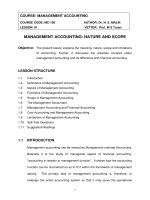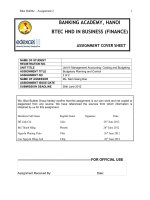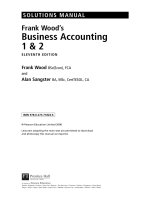Management accounting practice and strategic behavior by oliver gediehn
Bạn đang xem bản rút gọn của tài liệu. Xem và tải ngay bản đầy đủ của tài liệu tại đây (888.88 KB, 204 trang )
Oliver Gediehn
Management Accounting Practice and Strategic Behavior
Oliver Gediehn
Management Accounting
Practice and Strategic Behavior
On the Dysfunctional Effect of Short-Term
Budgetary Goals on Managerial Long-Term
Growth Orientation
With a foreword by Professor Dr. Utz Schäffer
RESEARCH
Bibliographic information published by the Deutsche Nationalbibliothek
The Deutsche Nationalbibliothek lists this publication in the Deutsche Nationalbibliografie;
detailed bibliographic data are available in the Internet at .
Dissertation European Business School Oestrich Winkel, 2008
D 1540
1st Edition 2010
All rights reserved
© Gabler | GWV Fachverlage GmbH, Wiesbaden 2010
Editorial Office: Ute Wrasmann | Anita Wilke
Gabler is part of the specialist publishing group Springer Science+Business Media.
www.gabler.de
No part of this publication may be reproduced, stored in a retrieval system
or transmitted, in any form or by any means, electronic, mechanical, photocopying, recording, or otherwise, without the prior written permission of the
copyright holder.
Registered and/or industrial names, trade names, trade descriptions etc. cited in this publication are part of the law for trade-mark protection and may not be used free in any form or by
any means even if this is not specifically marked.
Cover design: KünkelLopka Medienentwicklung, Heidelberg
Printed on acid-free paper
Printed in Germany
ISBN 978-3-8349-1535-1
Foreword
The starting point of this impressive piece of work by Oliver Gediehn is the muchcited conflict between the striving for short-term profitability and the pursuit of longterm growth of a company. The issue of how the operational dominance of annual or
even quarterly financial targets and the "short-termism" of the capital markets impact
innovation, adaptation, and growth is largely unresolved. In this context, research pays
special attention to the role of management accounting or "Controlling". Most
researchers assume a functional effect of management accounting practices and
systems on short-term goal achievement but a dysfunctional, or at least problematic,
effect on strategic management. This holds true for both literature on "economic shorttermism" as well as for studies in the field of "Reliance on Accounting Performance
Measures" (RAPM) research. Yet, most of these works are normative in nature or
based on anecdotal evidence only. Large empirical studies addressing the issue are rare
and inconclusive. As a result, Van der Stede (2000) calls for more empirical research
prompting Oliver Gediehn's first research question: "Does RAPM have a dysfunctional
effect on managerial long-term growth orientation?"
However, Oliver Gediehn does not confine his dissertation thesis to this rather narrow
research path. Rather, he places himself in the tradition of Hopwood (1983) who calls
for management accounting to be analyzed "in the context in which it operates" and
takes a research perspective based on Giddens' (1984) Structuration Theory. If one is
to apply Hopwood's thoughts properly, the long-term orientation of managers can
hardly be explained by management accounting practices alone. This results in Oliver
Gediehn's second and third research questions addressing the impact of other
organizational practices relative to RAPM.
To answer his three research questions, Oliver Gediehn conducts a large-scale case
study at a German technology and services company shaped and influenced both by its
founder as well as by a strong engineering and technology mindset. The candidate
portrays his case study as a "crucial case setup" which does not aim at rendering
generalizable results, but rather tries to falsify the proposed dysfunctional effect of
management accounting practices with one crucial case. He therefore chooses a case
where such a negative impact of management accounting practices on managerial
long-term orientation appears "most likely". In his research, Oliver Gediehn takes a
two-staged approach: First, he conducts 14 semi-structured interviews with various
managers at the corporate center and different business units. Second, he launches a
questionnaire survey with 832 middle managers from five business units achieving a
response rate above 50%. Considering the length of the questionnaire and the timing of
the survey just before the end of the budgetary year, the response rate has to be
deemed just as impressive as the extensive and close interaction with the company's
different management levels.
VI
Foreword
In conclusion, the survey results indicate the absence of a dysfunctional effect of
RAPM on managerial long-term orientation – despite strong anecdotal evidence
gathered during the interviews. Furthermore, Oliver Gediehn shows that selected
aspects of corporate entrepreneurship and strategy-making are highly relevant for the
analyzed relationships and exhibit higher explanatory power for the dependent
variables. These other organizational factors – at least within the context of the case
study – dominate the functional and dysfunctional effects of RAPM. These results and
the positive feedback received from both academia and practitioners prove that Oliver
Gediehn's research journey has been worthwhile: He has compiled a dissertation thesis
very much worth reading which contributes greatly to our understanding of the
interplay of management accounting practices and managerial long-term orientation. I
hope it receives a wide readership.
Utz Schäffer
Preface
Does the emphasis on short-term targets induce myopic management behavior? Well,
it at least has a strong "appeal of simplicity". Likewise, few people would strongly
oppose that management accounting and especially a rigid budgetary regime tend to
play a less favorable, i.e. dysfunctional role in the context of encouraging managerial
long-term orientation.
Accordingly, my strong hypothesis going into this research project was that the
emphasis on short-term budgetary targets – a pivotal aspect of the slightly clumsy term
Reliance on Accounting Performance Measures (RAPM) – is one key barrier to a
strong long-term growth orientation of the management at the researched company.
Yet, my findings in this respect were counterintuitive and did not correspond to the
dysfunctionality proposition described above. Once more, this research effort proved
that it is worthwhile to question or at least test and validate such common beliefs.
The results also show that often reality is not as simplistic as common wisdom might
suggest. Inspired by Giddens' Structuration Theory and its application in management
accounting research, my approach to analyzing the effects of RAPM was much
broader including a deliberate quest for "other organizational factors" in the context of
driving or inhibiting long-term orientation and strategic behavior. Eventually, these
other factors turned out to be much more important in the context of strategic
management behavior rendering management accounting and specifically RAPM as
just one driver among many.
The research was accepted as dissertation at the European Business School, OestrichWinkel, in August 2008.
A number of people deserve a special mention for their support during the course of
this academic journey. In particular, I want to thank
• Prof. Dr. Utz Schäffer for his continuous guidance and support, for being the
critical counterpart pushing my research further, and last but not least, for
providing me with this exceptional research opportunity.
• Prof. Dr. Dirk Schiereck for taking on the responsibility as my secondary
advisor at (very) short notice.
• Our partner organization and especially our two project sponsors without whom
we would not have been able to conduct this empirical piece of research. I also
want to thank the many company representatives who sacrificed part of their
time to share their perspectives during our interviews or in the questionnaire.
• All my colleagues for their valuable input at and around our monthly office
days as well as for making us external candidates feel "at home".
VIII
Preface
• My wife Katy, my daughters Fee and Leela, and my parents for their love,
support, and patience throughout these three years.
Oliver Gediehn
Contents
Foreword........................................................................................................................ V
Preface.........................................................................................................................VII
Contents ....................................................................................................................... IX
Tables ........................................................................................................................ XIII
Figures......................................................................................................................... XV
A
Introduction ............................................................................................................1
1. Research Issue and Objectives.................................................................................1
2. Plan of the Study ......................................................................................................4
B
Structuration Theory and Management Accounting Research ........................7
1. Structuration Theory as an Ontological Frame of Reference ..................................7
1.1.
Structuration Theory as Socio-Scientific Meta-Theory ................................7
1.2.
Post-Positivist Approach to Science .............................................................8
1.3.
Ontological Synthesis....................................................................................9
1.4.
Duality of Structure .....................................................................................10
1.5.
Research Informed by Structuration Theory...............................................12
1.6.
Critical Review on the Application of Structuration Theory ......................19
2. Structuration Theory in Management Accounting Research.................................22
2.1.
Previous Accounting Research Informed by Structuration Theory ............22
2.2.
Structurationist Research Perspective on Management Accounting ..........28
2.2.1.
Management Accounting as a Social Practice.........................................28
2.2.2.
Management Accounting within the Social Context...............................30
2.2.3.
Social Dimensions of Management Accounting Practices......................31
2.2.4.
Empirical Research in Management Accounting Informed by ST .........34
2.3.
C
Value of ST in Management Accounting Research ....................................39
Management Accounting and Managerial Long-Term Orientation ..............43
1. Debate on 'Economic Short-Termism' ...................................................................44
2. RAPM Research.....................................................................................................47
2.1.
Definition of RAPM ....................................................................................47
X
Contents
2.2.
Overview of the RAPM Research Stream...................................................49
2.3.
RAPM and Managerial Long-Term Orientation.........................................50
2.4.
Organizational Role Theory and RAPM Research .....................................52
2.4.1.
Basic Concepts of Role Theory ...............................................................52
2.4.2.
Application of Organizational Role Theory in RAPM Research ............54
2.5.
Social Dimensions of RAPM ......................................................................57
3. Research Gap and Research Questions..................................................................59
3.1.
3.1.1.
Persistence of Accounting-Based Performance Measures ......................59
3.1.2.
Increasing Relevance at the Middle Management Level ........................61
3.2.
Research Scope............................................................................................63
3.2.1.
Long-Term Growth Orientation as Part of Long-Term Orientation .......63
3.2.2.
The Relevant Organizational Context .....................................................67
3.3.
D
Research Gap...............................................................................................59
Research Questions .....................................................................................68
Research Design ...................................................................................................69
1. Research Approach ................................................................................................69
1.1.
Case Study Approach ..................................................................................69
1.2.
Two-Staged Design .....................................................................................70
1.3.
Crucial Case Setup ......................................................................................71
1.4.
Survey Design Parameters...........................................................................72
2. Research Site..........................................................................................................73
E
Field Interviews ....................................................................................................75
1. Purpose...................................................................................................................75
2. Method ...................................................................................................................76
2.1.
Selection of Informants ...............................................................................76
2.2.
Semi-Structured Interviews.........................................................................78
2.3.
Group Discussion ........................................................................................79
3. Results ....................................................................................................................81
3.1.
The Level of Managerial Long-Term Growth Orientation .........................81
3.2.
The Role and Relevance of RAPM .............................................................83
3.2.1.
Formal Incentive System .........................................................................84
Contents
3.2.2.
Extent of RAPM in Practice ....................................................................84
3.2.3.
Dysfunctional Consequences of the RAPM Practice ..............................86
3.3.
Other Relevant Factors of the Organizational Context ...............................87
3.3.1.
Corporate Entrepreneurship.....................................................................87
3.3.2.
Properties of the Strategy-Making Process ...........................................100
3.4.
F
XI
Propositions to Be Tested and Resulting Research Model .......................106
3.4.1.
Dysfunctional Effect of RAPM .............................................................106
3.4.2.
Impact of Corporate Entrepreneurship ..................................................106
3.4.3.
Impact of Strategy-Making....................................................................109
3.4.4.
Resulting Research Model.....................................................................110
Questionnaire Survey ........................................................................................113
1. Sample and Procedure..........................................................................................113
2. Measures ..............................................................................................................117
2.1.
Measure Development...............................................................................117
2.2.
Measure Validation ...................................................................................121
3. Results ..................................................................................................................125
3.1.
Dysfunctional Effect of RAPM.................................................................126
3.2.
Impact of Corporate Entrepreneurship ......................................................127
3.2.1.
Impact of Entrepreneurial Orientation on LGO ....................................127
3.2.2.
Impact of the Entrepreneurial Environment ..........................................128
3.2.3.
G
Impact of the Individual Proclivity for Entrepreneurship .....................130
3.3.
Impact of Strategy-Making .......................................................................132
3.4.
Relative Impact of RAPM and the Other Relevant Factors ......................133
Discussion and Outlook .....................................................................................139
1. Theoretical Implications ......................................................................................139
1.1.
On the Dysfunctional Effect of RAPM .....................................................139
1.2.
On the Other Relevant Organizational Factors .........................................141
1.3.
On RAPM Research Informed by Structuration Theory...........................145
1.4.
On Management Accounting Practice and Strategic Behavior.................150
2. Managerial Implications ......................................................................................153
2.1.
RAPM........................................................................................................153
2.2.
Corporate Entrepreneurship ......................................................................154
XII
Contents
2.3.
Strategy-Making ........................................................................................156
3. Limitations and Outlook ......................................................................................158
Appendix .....................................................................................................................161
References ...................................................................................................................171
Tables
Table 1: Studies Informed by Structuration Theory .................................................... 24
Table 2: RAPM Studies with Long-Term Orientation as a Dependent Variable ......... 51
Table 3: Overview Field Interviews ............................................................................. 78
Table 4: Corporate Entrepreneurship Classification Typologies.................................. 88
Table 5: Organizational Antecedents for Corporate Entrepreneurship ........................ 91
Table 6: Ten Schools of Strategy-Making .................................................................. 101
Table 7: Strategy-Making Modes ............................................................................... 104
Table 8: Inter-Item Reliability .................................................................................... 121
Table 9: Overview SEM Goodness-of-Fit Measures.................................................. 123
Table 10: Descriptive Statistics .................................................................................. 125
Table 11: Results Moderated Regression Analysis .................................................... 136
Figures
Figure 1: Plan of the Study ............................................................................................. 4
Figure 2: Giddens' Duality of Structure Framework .................................................... 14
Figure 3: Frequency of Studies Informed by Structuration Theory 1985-2007 ........... 25
Figure 4: Management Accounting Practices as Modalities of Structuration .............. 33
Figure 5: Overview on Variables in RAPM Research.................................................. 50
Figure 6: Integrated Perspective on Corporate Entrepreneurship................................. 95
Figure 7: Overview Research Model and Hypotheses ............................................... 111
Figure 8: Sample Composition by Business Unit and Management Level ................ 115
Figure 9: Sample Composition by Function ............................................................... 115
Figure 10: Sample Composition by Age and Tenure ................................................. 116
Figure 11: Structural Model Dysfunctional Effect of RAPM .................................... 126
Figure 12: Structural Model EO on LGO ................................................................... 127
Figure 13: Structural Model EO on LGO (modified) ................................................. 128
Figure 14: Structural Model Entrepreneurial Environment on EO ............................ 129
Figure 15: Structural Model Traits on LGO ............................................................... 130
Figure 16: Structural Model EXPLOIT vs. EXPLORE ............................................. 131
Figure 17: Structural Model Strategy-Making Modes on LGO ................................. 132
Figure 18: Relative Impact on LGO ........................................................................... 134
A Introduction
"Without continual growth and progress, such words as improvement, achievement, and
success have no meaning."
Benjamin Franklin
1. Research Issue and Objectives
Achieving sustainable sales growth has recently been among the most important topics
for business managers in large corporations. Practitioner journals portrait companies in
a "do-or-die struggle"1 for sustained and profitable growth2 and explore the sources3,
drivers4, and processes of growth5. The attempt to achieve a favorable long-term sales
growth trajectory complements the continuous strive for profitability and operational
excellence – and creates a latent conflict between short-term efforts for profitability
and long-term concerns for growth.6
Academic research mirrors this conflict and its implications in the stream of literature
devoted to the balancing of short-term goal achievement and the encouragement of
strategic management behavior or, more generally, managerial long-term orientation.7
While short-term goal achievement relates mostly to the attainment of budgetary
targets 8 or financial planning targets, in general, the operationalization of strategic
behavior and long-term orientation is manifold. It includes the strive for strategic
renewal 9 , innovation and adaptation 10 , the concern for long-term positioning and
growth11, as well as the pursuit of entrepreneurial initiatives12.
A prominent topic of this stream of research is the role and relevance of management
accounting. To the most part, researchers see current management accounting systems
and practices as functional with respect to short-term goal achievement but as
dysfunctional or at least problematic with respect to the encouragement of strategic
management behavior. The literature on 'economic short-termism' for example
1
Smit/Thompson/Viguerie (2005), p. 405.
Seurat (1999), p. 53; Heffes/Sinnett (2006), p. 36.
3 Oliva (2003), pp. 39-41.
4 Baghai/Smit/Viguerie (2007), pp. 45-48.
5 Stewart (2006), pp. 62-64.
6 Seurat (1999), p. 53.
7 Simons (1995), p. 91; Frow/Marginson/Ogden (2005), p. 270.
8 Frow/Marginson/Ogden (2005), p. 271.
9 Simons (1994), p. 169; Crossan/Berdrow (2003), p. 1087.
10 Simons (1995), p. 92.
11 Heidmann (2008), p. 71.
12 Dent (1990), p. 3.
2
2
Introduction
Part A
proposes the short-term focus on "flawed"13 management (accounting) practices as one
potential root cause for myopic management behavior. 14 Similarly, the Reliance on
Accounting Performance Measures (RAPM) research stream assigns an excessive
short-term focus as dysfunctional effect to the traditional (accounting-based)
management control system.15
A common characteristic of these two streams of research is the narrow quantitative
empirical base. The impact of the allegedly flawed management practices on economic
short-termism builds largely on theoretical arguments while the scarce empirical
evidence is only circumstantial or anecdotal in nature. 16 The various dysfunctional
consequences of RAPM including motivational aspects of job satisfaction or jobrelated tension as well as behavioral aspects such as tactical gaming or data
manipulation are subjects of extensive empirical research. Yet, only few studies deal
with the particular issue of managerial long-term orientation17 and those that do, fail to
deliver conclusive results due to conceptual and methodological limitations.18
In summary, the existing management accounting literature "is still inconclusive"19 to
answer as to whether current management accounting practices and in particular the
dominant RAPM practice have a dysfunctional effect on managerial long-term
orientation. Consequently, the study responds to Van der Stede's (2000, p. 120) call for
future research on this topic and aims to render a more definite answer on the
existence of the dysfunctional effect ideally reconciling the previous anecdotal and
quantitative empirical evidence. Reflecting the currently prevailing concern for growth
in practice, the study explicitly addresses long-term growth orientation as an element
of strategic management behavior and the more inclusive notion of managerial longterm orientation.
This approach results in the following first research question guiding the study:
• Does RAPM have a dysfunctional effect on managerial long-term growth
orientation?
13
Laverty (1996), p. 831.
Hayes/Abernathy (1980), p. 70; Laverty (1996), pp. 831-832.
15 Van der Stede (2000), p. 611; for an overview on the RAPM research stream, cf. Briers/Hirst
(1990); Hartmann (2000).
16 Merchant (1990), p. 297; Laverty (1996), p. 837.
17 Only 3 of the 28 and 46 studies reviewed by Briers/Hirst (1990) and Hartmann (2000), respectively,
explicitly included long-term concerns as dependent variable.
18 Van der Stede (2001), p. 120. For the limitations refer to Briers/Hirst (1990), pp. 392-395;
Hartmann (2000), pp. 465-469.
19 Van der Stede (2000), p. 120.
14
Part A
Research Issue and Objectives
3
The study is conducted in the tradition of Hopwood's call to study management
accounting "in the context in which it operates".20 It thus acknowledges the fact that
research on accounting practices needs to explicitly consider linkages to the other
organizational processes and practices as unique contextual variables in particular
organizational settings. 21 In line with this research tradition, the study assumes a
research perspective that is informed by Anthony Giddens' (1984) Structuration
Theory (ST). Macintosh, Roberts, and Scapens have introduced Giddens' ideas into
management accounting research as an "alternative avenue for research"22 that takes
into account both technical and interpersonal aspects and, more generally, views
management accounting as social practice to be analyzed within its organizational
context.23 As "focused, informative, integrative, and efficient, yet comprehensive"24
framework for the study of accounting in the particular context in which it operates,
Structuration Theory provides a suitable ontological frame of reference to guide this
research effort.
Following Hopwood's argument, the balancing of short- and long-term concerns – and
therefore also extent of strategic management behavior as organizational outcome –
results from the complex interplay of different organizational practices – with
management accounting constituting only one of them. 25 The scope of the study is
therefore extended beyond the properties of management accounting to include other
relevant organizational practices that impact managerial long-term orientation, in
general, and a manager's long-term growth orientation in particular. The second
research question consequently addresses this exploratory research issue:
• Which other organizational practices impact long-term growth orientation?
To determine the theoretical as well as practical relevance of any dysfunctional effect
of the RAPM practice, the study finally assesses its impact relative to that of the other
organizational practices that prove to be influential. The third research question
therefore connects the first two research issues:
• How relevant is RAPM with respect to managerial long-term growth orientation
considering the other organizational practices?
20
Hopwood (1983).
Ibid., pp. 292-293.
22 Roberts/Scapens (1985), p. 455.
23 Ibid., pp. 443-444, 453-455; Macintosh/Scapens (1990), pp. 455-456, 474-476.
24 Macintosh/Scapens (1990), p. 475.
25 Hopwood (1983), p. 291; Boland (1993), p. 127.
21
4
Introduction
Part A
2. Plan of the Study
After the introductory Part A, the research report is structured along the three main
phases of the research process: First, the establishment of a theoretical foundation and
review of previous research (Parts B and C), second, the design and conduct of the
empirical research (Parts D, E, and F) and third, the discussion and interpretation of
the results and derivation of implications for theory and practice (Part G) (see also
Figure 1).
Introduction
Part A
Research Issue and
Objectives
Theory and Previous
Research
Part B
Structuration
Theory and
Management
Accounting
Research
Part C
Impact of
Management
Accounting on
Managerial LongTerm Orientation
Empirical Research
Part D
Research Design
and Research Site
Part E
Phase I:
Field Interviews
Discussion of Results
Part G
Theoretical and
Managerial
Implications,
Limitations, and
Outlook
Part F
Phase II:
Questionnaire
Survey
Figure 1: Plan of the Study
Part B introduces Anthony Giddens' (1984) Structuration Theory as ontological frame
of reference for this study and outlines the characteristics of empirical research
informed by Structuration Theory. Furthermore, it reviews previous applications of
Giddens' theory in management accounting research and carves out the cornerstones of
a 'Structurationist' research perspective on management accounting.
Part C first gives an overview on the existing literature concerned with the impact of
management accounting on managerial long-term orientation. It describes the scope,
findings, and limitations of the two predominant streams of research that deal with this
relationship: The research on 'economic short-termism' as part of the general
management literature and the research on the Reliance on Accounting Performance
Measures (RAPM) as one of the core streams in management accounting research.
Against thE background of previous contributions, the research gap, the scope of the
study, and the specific research questions are deducted.
Part D details the chosen research design. It outlines the two-staged case-study
approach through the combination of semi-structured interviews and a questionnaire
survey and highlights the conceptual and methodological improvements with respect
Part A
Plan of the Study
5
to previous studies. It also provides an introduction to the divisionalized German
manufacturing company selected as research site.
Part E gives a detailed account of the first phase of empirical research, a series of 14
semi-structured interviews at both the corporate center and a set of business units
followed by two rounds of group discussion. After outlining purpose and method of
the interviews, the results of this research phase are presented in terms of the role and
relevance of RAPM on the one hand and other organizational practices on the other
hand. Based on the anecdotal evidence gathered, the theoretical propositions to be
tested in the subsequent survey are derived and presented in the resulting research
model.
Part F describes the second phase of empirical research, a survey among 412 members
of the middle management to validate the propositions derived during the interview
phase. It details the survey design, the development and validation of the measures, the
descriptive statistics as well as the results obtained from structural equation modeling
(SEM) employing the LISREL software package.
Part G summarizes the study's main contributions and implications with respect to
management accounting theory and practice. It concludes with a discussion of the
study's limitations and gives an outlook on promising directions for future research
addressing these shortcomings.
B Structuration Theory and Management Accounting Research
This part of the research report sets the stage for a management accounting research
effort informed and guided by Anthony Giddens' (1984) Structuration Theory (ST). It
first outlines the dominant features of Structuration Theory, in general, (Chapter B1)
and then, more specifically, describes the application of Giddens' theory in the realm
of management accounting research (Chapter B2).
1. Structuration Theory as an Ontological Frame of Reference
This chapter presents Structuration Theory as an ontological foundation for socioscientific research in adherence to a post-positivist philosophy of science (Sections
B1.1 to B1.3). It then presents the most important concepts of Structuration Theory
centering on the Duality of Structure (Section B1.4) and describes characteristics of
empirical research informed by ST (Section B1.5). The chapter concludes with a
critical review of Giddens' contribution (Section B1.6).
1.1. Structuration Theory as Socio-Scientific Meta-Theory
For the application of the concepts of Structuration Theory on a specific research
effort the nature or status of Giddens' theoretical contribution has to be acknowledged.
In positioning Structuration Theory, authors refer to it as "theoretical approach" 26 ,
"theoretical framework"27, "ontological theory, at a high level of abstraction", "sociophilosophical […] view"28, "conceptual framework"29, or "ontology of potentials"30.
Giddens himself aimed to develop an "ontological framework for the study of human
social activities"31, stressing the meta-theoretical status32 of Structuration Theory.
When positioning Structuration Theory, it is useful to distinguish formal social theory
on the one hand and substantial or empirical sociological theory on the other.33 The
former deals with fundamental philosophical and ontological assumptions of socioscientific research like the "nature of social action, social relations, social systems"34
and constitutes "a domain for inquiry."35 The latter deals with social phenomena in a
26
Bernstein (1989), p. 19.
Held/Thompson (1989a), p. 2.
28 Jochoms/Rutgers (2005), pp. 391, 405.
29 Willmott (1987), p. 258.
30 Cohen (1989), p. 11.
31 Giddens (1991), p. 201.
32 Cohen (1989), p. 11.
33 Jochoms/Rutgers (2005), p. 405; accordingly, Cohen distinguishes "ontological conceptualizations
of fundamental entities or mechanism" and "substantive theory" (Cohen (1989), p. 17; De
Cock/Rickards (1995), p. 700).
34 Cohen (1989), p. 2.
35 De Cock/Rickards (1995), p. 700.
27
8
Structuration Theory and Management Accounting Research
Part B
given context, is thereby subject to epistemological and methodological constraints,
and directly linked to empirical research. 36 Structuration Theory is a formal social
theory as it explicitly concentrates on the ontological aspects of social theory37 where
epistemological concerns are not (yet) relevant and factors out substantive social
processes and their empirical accounts.38
1.2. Post-Positivist Approach to Science
With respect to the major streams in the philosophy of science, Structuration Theory
can be positioned as post-positivist 39 or post-empiricist. 40 Positivism refers to the
classical principles that the formation of knowledge can only stem from the (positive)
affirmation of theories through empirical observation. From a positivist or empiricist
perspective, a theory has to be a deductively developed set of laws and generalizations.41 While well applicable to the natural sciences, these principles have limited
value in the social sciences where all existing 'theories' are underdetermined by fact.
This inevitable void would render all theoretical consideration a pre-theoretical
status. 42 Post-positivist and post-empiricist researchers therefore abandon these
idealistic claims and propose to fill the void with ontological or metaphysical
postulates.43
Within the philosophy of science, these postulates are referred to as "metaphysical
ideas" 44 not justifiable by the means of empirical research, answers to questions
concerning the existence and interaction of fundamental entities45, the "hard core" or
"positive heuristic" of any "research programme" 46 , metaphysical commitments as
ontologies specifying certain research domains47, or "intransitive objects".48
Giddens' Structuration Theory explicitly addresses these fundamental assumptions that
are often only tacitly presupposed in research efforts.49 He clearly takes a post-positivist position by formulating the theory in ontological terms purposely excluding any
epistemological issues.
36
Ibid; Jochoms/Rutgers (2005), p. 405.
Giddens (1984), p. xx.
38 Cohen (1989), p. 1.
39 Ibid., pp. 12-18; Bryant/Jary (1991b), p. 27.
40 Giddens/Turner (1987), p. 2; De Cock/Rickards (1995), p. 700.
41 Giddens (1984), p. xviii.
42 Ibid; Cohen (1989), p. 15.
43 Cohen (1989), p. 15.
44 Popper (1968), p. 38.
45 Kuhn (1970), pp. 4-5.
46 Lakatos (1978), pp. 47-52, 110-11, 115.
47 Laudan (1977), p. 79.
48 Bhaskar (1978), p. 45.
49 Cohen (1989), pp. 1-2.
37
Part B
Structuration Theory as an Ontological Frame of Reference
9
1.3. Ontological Synthesis
Giddens formulated his Structuration Theory in response to one of the most prevailing
issues in the social sciences, the dichotomist relation between structure and agency, or
more broadly speaking between society and the individual.50 This issue has prompted
competing ontologies which became manifest in competing schools of thought.
The macro-theory in the social sciences, on the one hand, stresses the deterministic,
objective, and static notion of structure.51 The macro view has informed the positivistic, functionalistic, and naturalistic schools of thought52 which Giddens refers to as
"orthodox concensus." 53 Characterizing them as "strong on institutions, weak on
action"54, he criticizes these schools for neglecting the active constitution as well as
the time-space context of social life and for exclusively focusing on observable
structures.55
On the other hand, the micro-theory centers on the voluntaristic, subjective and
dynamic notion of individual agency.56 Related schools in fundamental opposition to
the "orthodox concensus" include hermeneutics, phenomenology, and interpretative
sociology.57 According to Giddens, they put too much emphasis on the intentions of
the acting individual and not adequately account for the impact of structures and
institutions. 58 Consequently, he labels them as "strong on action, weak on
institutions."59
Structuration Theory purposely does not embrace either one of these ontologies as
Giddens questions their mutual exclusivity. 60 He does not want to continue the
dualistic debate of competing ontologies but seeks to move beyond the dichotomist
logic to explore a new understanding of the relationship between structure and agency.
In this respect, Structuration Theory can be seen in line with other classical approaches
that avoid and eventually overcome the dualistic perspective.61
50
Thompson (1989), p. 56; Pozzebon (2004), p. 252.
Barley/Tolbert (1997), p. 97; Jochoms/Rutgers (2005), p. 391.
52 Thompson (1989), p. 57; Barley/Tolbert (1997), p. 97; Jochoms/Rutgers (2005), p. 391.
53 Giddens (1984), p. xv.
54 Giddens (1982), p. 29.
55 Jochoms/Rutgers (2005), p. 391.
56 Barley/Tolbert (1997), p. 97; Jochoms/Rutgers (2005), p. 391.
57 Thompson (1989), p. 58; Barley/Tolbert (1997), p. 97; Jochoms/Rutgers (2005), p. 391.
58 Giddens (1976), p. 134; Jochoms/Rutgers (2005), p. 391.
59 Giddens (1982), p. 29.
60 Pozzebon (2004), p. 249.
61 Examples include the work by Bourdieu (1977) on the relationship between subjectivism and
objectivism, the attempt by Bernstein (1983) to overcome objectivism and realism, the treatment of
positivism by Bhaskar (1989), and the recent discussion of the interplay between science and
hermeneutics by Fay (1996) (cf. Pozzebon (2004), p. 250).
51
10
Structuration Theory and Management Accounting Research
Part B
Rather than stressing their opposition, Giddens builds on the complementarity of
structure and agency in a process-oriented theory62 and presents an (abstract) ontological synthesis where the Duality of Structure as central theme replaces the dualism
of structure and agency ontologies.63
The following section elaborates on Giddens' Duality of Structure, which is the pivotal
concept of Structuration Theory.
1.4. Duality of Structure
Giddens' Duality of Structure attempts to "reconcile [individual] social action with
collective dimensions of social life."64 Prior to the presentation of the interdependent
and complementary relationship of structure as collective dimension and agency as
individual counterpart, this section reviews Giddens' definitions of both terms as well
as of the more general terms social practices and social systems.
Central to Giddens' ontological approach is the notion of social practices ordered
across space and time65, which "can be understood as skilful procedures, methods, or
techniques, appropriately performed by social agents." 66 As recursively reproduced
human social activity, they constitute social life and should therefore be the primary
domain of inquiry in the social sciences.67 The application of social practices by social
agents requires both resources and skills, where the necessary skills or knowledge can
be tacit or explicit in nature.68 Inherent in the concept of social practices is also the
aspect of intervention, i.e. the transformative reproduction of social life, as knowledgeable agents can apply these methods to influence the course and outcome of social
activity.
Social systems, in general, as well as organizations, in particular, are defined as a set of
empirically observable, regular social practices linking agents across time and space.69
They account for similar social relations and activities between individual agents or
collectivities70 but have no existence beyond the social practices that constitute them.71
62
Sewell Jr. (1992), p. 4; Barley/Tolbert (1997), p. 97.
Jochoms/Rutgers (2005), p. 396.
64 Cohen (1989), p. 10.
65 Giddens (1984), pp. 2-4; Cohen (1989), pp. 26-30.
66 Cohen (1989), p. 26.
67 Giddens (1984), p. 2.
68 Giddens (1984), p. 4 refers to the knowledge as mutual knowledge and differentiates practical and
discursive consciousness, accordingly.
69 Giddens (1984), p. 25; Sewell Jr. (1992), pp. 5-6.
70 Giddens (1984), p. 28, refers to the so-called reciprocity of practices between actors or collectivities.
71 Sewell Jr. (1992), p. 6.
63
Part B
Structuration Theory as an Ontological Frame of Reference
11
In Giddens' terms, a social system is the "pattering of social relations across time-space,
understood as reproduced practices."72
In the glossary to "The Constitution of Society", Giddens defines structure as follows:
"Rules and resources, recursively implicated in the reproduction of
social systems. Structure exists only as memory traces, the organic
basis of human knowledgeability, and as instantiated in action."73
This definition includes the following key properties: 74 Structure is comprised of
generalizable and transposable procedures (rules) and sources of power (resources),
both applicable in social interaction. The repeated instantiation of these rules and
resources accounts for the reproduction of social practices and therefore allows for the
binding of social systems across time and space (recursively implicated in the
reproduction of social systems). Accordingly, social systems do not have a structure
but exhibit structured or institutionalized features. Structure is a "virtual order" 75
governing the transformative reproduction of social systems that only exists in the
form of ideas or schemata in human memory (memory traces, the organic basis of
human knowledgeability) or applied in practice (instantiated in action).
In his definition of agency, Giddens applies a rather broad concept that goes beyond
the concept of human agency as flow of intentional action. 76 Making the status of
event dependent upon an agent's intention does not render an independent frame of
reference to define human agency in absolute terms. In defining agency, Giddens
therefore applies a concept that centers on the capability of acting and not on their
intentions or (intended) consequences. His litmus test is whether "the individual could,
at any phase in a given sequence of conduct, have acted differently"77. This definition
allows him to include unintended consequences, which can also have systematic
impact on the flow of actions, into the modeling of human agency.
In Structuration Theory, Giddens moves beyond portraying structure and agency as
counteracting elements of a dichotomy or dualism but rather conceives them as
complementary terms of his Duality of Structure. 78 He purposely does not sub- or
superordinate one versus the other and therefore does not decide on the ultimate
72
Giddens (1984), p. 377.
Ibid.
74 Ibid., p. 17; Sewell Jr. (1992), pp. 6-10.
75 Giddens (1984), p. 17.
76 Ibid., pp. 8-14.
77 Ibid., p. 9.
78 Thompson (1989), p. 58.
73
12
Structuration Theory and Management Accounting Research
Part B
prevalence of either agency or structure. They are rather said to exhibit a complex,
dynamic relationship that is non-causal and non-linear in nature.79
In Giddens' terms, the Duality of Structure means that "social structures are both
constituted by human agency, and yet are the same time are the very medium of this
constitution."80 The first aspect refers to the fact that the structural properties of social
systems are the outcome of agency in the form of the application of social practices.
The instantiation of these practices through individual agency, thus, (re)produces
structure. In contrast, individual agency constantly draws on the virtual rules and
resources of structure. Thus, their "action is structured"81 or in other words is to a
certain extent governed by the structural and institutional properties of the social
system. In this sense, structure and agency, "far from being opposed, in fact presuppose each other."82
Giddens and many of his followers refer to the analogy of langue et parole, of
language and speech 83 to illustrate the relationship between structure and agency.
While language comprises the abstract rules for the (re)production of grammatical
sentences, (acts of) speech are the instantiation or enactment of these abstract rules in
the production of specific grammatical sentences. Meaningful (acts of) speech are in
that sense enabled by the virtual existence of language, whereas at the same time, the
(re)production (and transformation) of language requires its application in specific acts
of speech.
The complementary and interdependent interplay of structure and agency under the
regime of the duality of structure occurs over time in the recursive (re)production
process of social systems – in the so-called structuration process. 84 Whittington 85
rightfully argues that Giddens inserted his concept of social systems between structure
and agency to overcome the dichotomist logic and create the interdependent duality:
"Social systems are constituted by the activities of human agents, enabled and constrained by the structural properties of these systems."86
1.5. Research Informed by Structuration Theory
The following section examines the characteristics of research 'informed by'
Structuration Theory. Specifically, it will be reviewed how the meta-theoretical status
impacts the application of Structuration Theory in research and how it relates to other
79
Jochoms/Rutgers (2005), pp. 386-387.
Giddens (1976), p. 121.
81 Thompson (1989), p. 56.
82 Sewell Jr. (1992), p. 4.
83 Giddens (1976), pp. 118-122; Sewell Jr. (1992), p. 6.
84 Jochoms/Rutgers (2005), p. 386.
85 Whittington (1992), p. 695.
86 Ibid.
80









